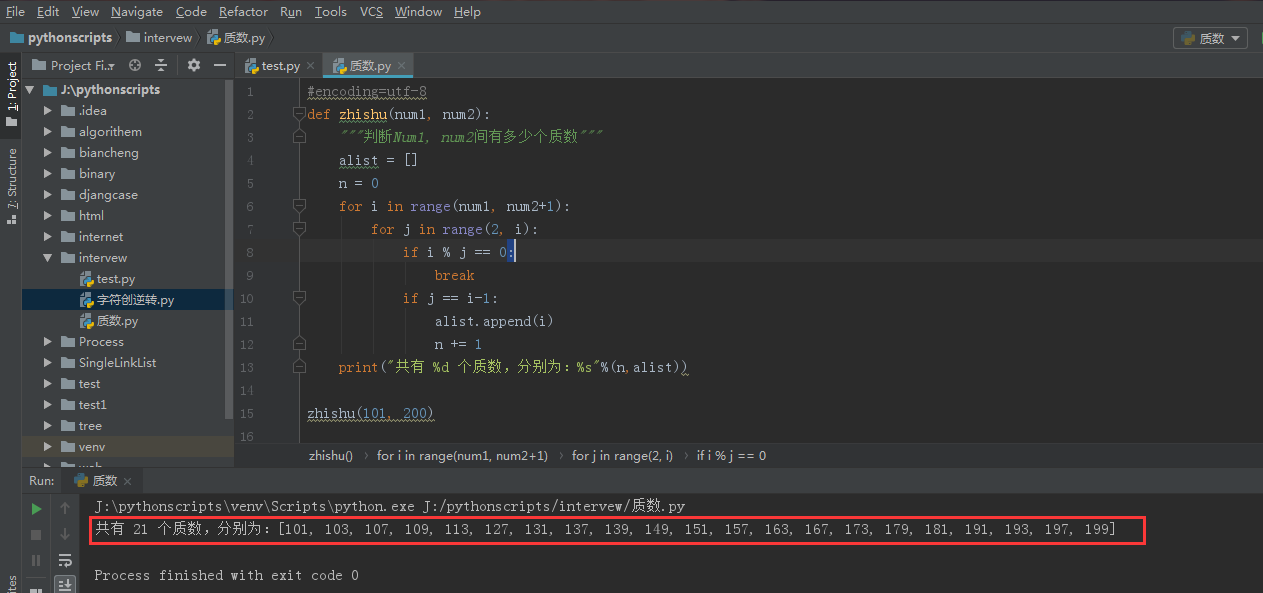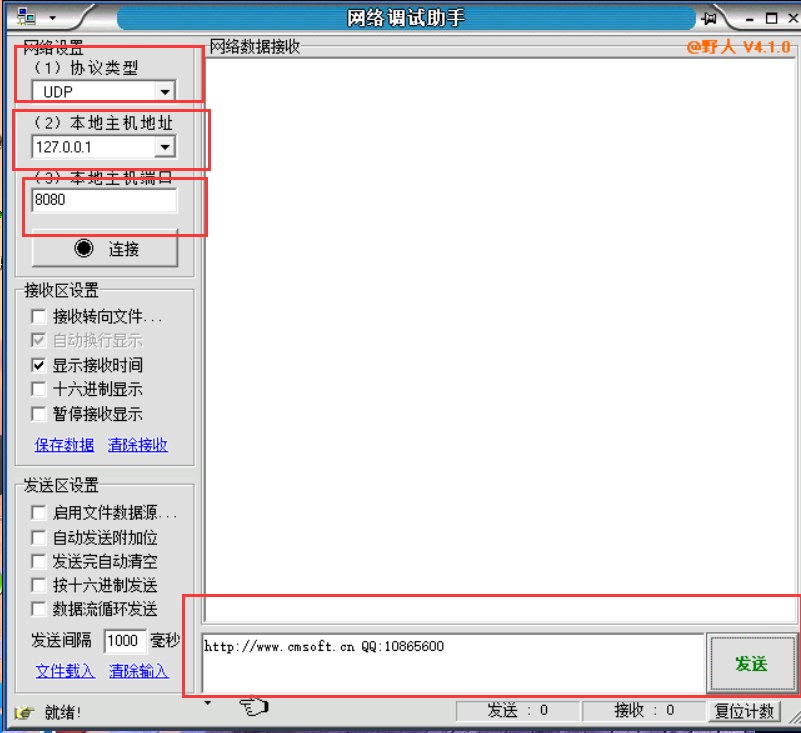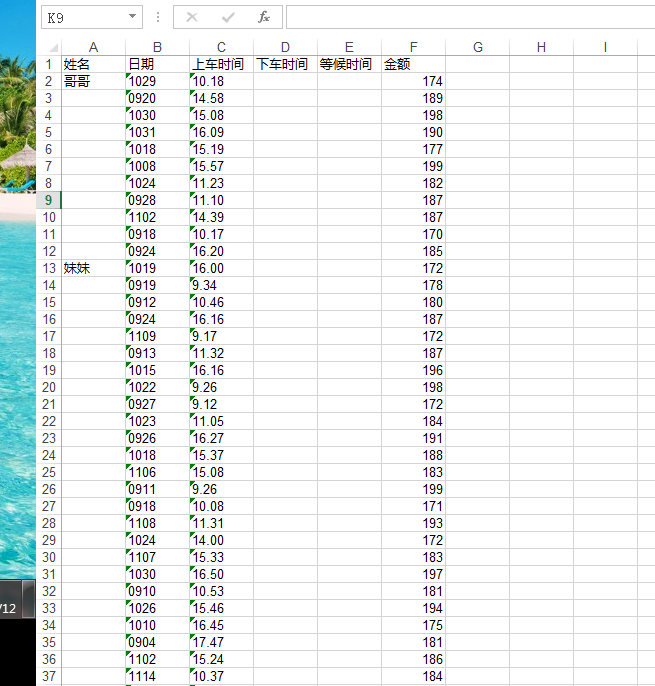1. 反转字符串:
1 #encoding=utf-8 2 #import string 3 from collections import deque 4 5 def reverse1(string): 6 """利用切片""" 7 return string[::-1] 8 9 def reverse2(string): 10 """1. 将字符串转为列表,利用列表的reverse()函数反转 2. 使用join连接""" 11 alist = list(string) 12 alist.reverse() 13 newString = "".join(alist) 14 return newString 15 16 def reverse3(string): 17 """利用双端队列,双端队列左侧进右侧出""" 18 q = deque() 19 q.extendleft(string) #注意:extendleft(string)会将字符串string反向存入到双端队列中 20 return "".join(q) 21 22 def reverse4(string): 23 """递归的方式,每次只取一个字母""" 24 if len(string)<=1: 25 return string 26 else: 27 return reverse4(string[1:]) + string[0] 28 29 def reverse5(string): 30 """交换首尾字符的位置""" 31 alist = list("".join(string.split(" "))) 32 for i, j in zip(range(len(alist)/2), range(len(alist)-1, 0, -1)): 33 alist[i], alist[j] = alist[j], alist[i] 34 return "".join(alist) 35 36 def reverse6(string): 37 """利用fort循环从右往左输出""" 38 list = [] 39 for i in range(len(string)-1, -1, -1): 40 list.append(string[i]) 41 return "".join(list) 42 43 44 45 46 if __name__ == "__main__": 47 string = "I am a string" 48 print(reverse1(string)) 49 print reverse2(string) 50 print reverse3(string) 51 print reverse4(string) 52 print reverse5(string) 53 print reverse6(string)
2. 求num1到num2间的质数及其个数。
1 #encoding=utf-8 2 def zhishu(num1, num2): 3 """判断Num1, num2间有多少个质数""" 4 alist = [] 5 n = 0 6 for i in range(num1, num2+1): 7 for j in range(2, i): 8 if i % j == 0: 9 break 10 if j == i-1: 11 alist.append(i) 12 n += 1 13 print("共有 %d 个质数,分别为:%s"%(n,alist)) 14 15 zhishu(101, 200)

3. 求两个列表的交集,并集,补集。
1 #encoding=utf-8 2 def interSection(alist1, alist2): 3 """利用集合set求交集、并集""" 4 alist1_set = set(alist1) 5 alist2_set = set(alist2) 6 Intersection = alist1_set.intersection(alist2_set) #交集 7 Union = alist1_set.union(alist2_set) #并集 8 Difference = alist1_set.difference(alist2_set) #在集合alist1_set中但不在集合alist2_set中 9 Sym_difference = alist1_set.symmetric_difference(alist2_set) #两集合交集的补集 10 Intersection_alist = list(Intersection) 11 Union_alist = list(Union) 12 Difference_alist = list(Difference) 13 Sym_difference_alist = list(Sym_difference) 14 print("两个集合的交集为:%s\n两个集合的并集为:%s\n在集合a中但不在集合b中的集合为:%s\n集合a,b交集的补集为%s"%(Intersection_alist,Union_alist, Difference_alist, Sym_difference_alist)) 15 16 17 if __name__=="__main__": 18 alist1 = ["a", "b", "d", 1, 5, 7] 19 alist2 = ["a", "c", "d", 3, 5, 9] 20 interSection(alist1, alist2)

4. 快速求链表中间节点
1 #coding:utf-8 2 class Node(object): 3 def __init__(self, item): 4 self.item = item 5 self.next = None 6 7 class SingleLinkList(object): 8 def __init__(self, node=None): 9 self.head = node 10 11 def appendList(self,item): 12 node = Node(item) 13 cur = self.head 14 if self.head == None: 15 self.head = node 16 else: 17 while cur.next != None: 18 cur = cur.next 19 cur.next = node 20 21 def travle(self): 22 if self.head == None: 23 print ("This is an empty List!") 24 else: 25 cur = self.head 26 while cur != None: 27 print cur.item, 28 cur = cur.next 29 print ("\n") 30 31 def find(self, k): 32 count = 1 33 cur = self.head 34 if self.head == None: 35 print ("No nodes!") 36 else: 37 while cur.next != None: 38 if count == k: 39 print cur.item 40 break 41 else: 42 count += 1 43 cur = cur.next 44 def findCerter(self): 45 count, count2 = 0, 0 46 cur = self.head 47 cur2 = self.head 48 if self.head == None: 49 print ("No nodes!") 50 else: 51 while cur != None: 52 count += 1 53 cur = cur.next 54 print count 55 while cur2.next != None: 56 if count2 == count/2 and count % 2 == 0: 57 print cur2.item,cur2.next.item 58 break 59 elif count2 == count/2 and count % 2 != 0: 60 print cur2.item 61 break 62 else: 63 count2 += 1 64 cur2 = cur2.next 65 66 67 68 if __name__ == "__main__": 69 list = SingleLinkList() 70 for i in range(9): 71 list.appendList(i) 72 list.travle() 73 list.find(3) 74 list.findCerter()
5. 需求:(1)文本分割:按IP地址分割文件,同时以IP地址命名新文件。
(2)检索出某用户名所在的所有IP地址
原文本信息如下:
------------------------------ IP 192.168.109.31 用户名 用户主组名 附属组 nobody nobody nogroup xxx users xxxx xxxx xxxx xxxx xxxx xxxxx xxxx ------------------------------ IP 192.168.109.32 用户名 用户主组名 附属组 nobody nobody nogroup xxxx users xxxx xxxx aiuap xxxxx xxxx xxxxx users
#encoding=utf-8
import re
import os
"""文本按IP地址分割成多个已IP地址命名的小文件"""
#1. 读取文件每行,当匹配到该行有"IP"时,创建新的文件并以该行命名,同时往一个文件中写,如果匹配到下一个IP,则重新写入到新文件,
def splitText(file):
f = open(file)
newFile = open("temp", "w")
for line in f.readlines():
if re.search("IP", line):
newFile.close()
newFile = open(line.split(" ")[1].strip(), "w")
newFile.write(line)
f.close()
def searchIp(file):
f = open(file, "r")
dic = {}
ip = []
for line in f.readlines():
# print os.popen('tr -s ["\n"]< %s'%file).readlines() #python调用shell命令可以将文本中的空行去除,os.popen()返回的是文件,os.system()返回的是shell指令运行退出后的状态码。
if re.search("IP", line):
ip = line.split(" ")[1].strip()
continue
elif re.match("---", line) :
continue
elif re.match("用户名", line):
continue
else:
user = line.split(" ")[0].strip()
if user:
if dic.has_key(user):
dic.get(user).append(ip)
else:
dic.setdefault(user, []).append(ip) #键user不在字典中,则新增[user: ip]
print dic
下面同事写的:
def getAllDiraccount(path):
stack = []
set1 = set()
stack.append(path) # 处理栈,当栈为空的时候结束循环
while len(stack) != 0: # 从栈里取出数据
dirPath = stack.pop()
# print(dirPath)
# 目录下所有文件
filesList = os.listdir(dirPath)
# print(filesList)
# 处理每一个文件,如果是普通文件则处理找出,如果是目录则将该目录的地址压栈
for fileName in filesList:
fileAbsPath = os.path.join(dirPath, fileName)
if os.path.isdir(fileAbsPath): # 是目录就压栈
print("目录:" + fileName)
stack.append(fileAbsPath)
else:
# 找到了普通文件里面的所有账号
print("普通文件:" + fileAbsPath)
res = os.popen("awk '{print $1}' %s" % (fileAbsPath))#调用shell指令,取出文件第一列数据。
for temp in res.readlines():
set1.add(temp.strip())
print(list(set1))
if __name__=="__main__":
#splitText("user")
searchIp("user")
getALLDiraccount("J:\peng")

6. 输出某路径下的所有文件和目录下的所有文件。
1 #encoding=utf-8 2 import os 3 #获取当前路径 4 # print os.getcwd() 5 def findFileDir(path): 6 """判断该路径下是文件还是目录,如果是文件则输出,如果是目录则输出目录下的文件。""" 7 fileDirList = os.listdir(path) #返回指定目录path下的所有文件和目录名 8 dic = {} 9 for file in fileDirList: 10 newPath = path + '/' + file 11 if os.path.isdir(newPath): 12 findFileDir(newPath) 13 elif os.path.isfile(newPath): 14 if dic.has_key(path): 15 dic.get(path).append(file) 16 else: 17 dic.setdefault(path, []).append(file) 18 else: 19 return 1 20 print("%s目录下的文件有:%s"%(dic.keys(), str(dic.values()).strip("[]"))) 21 22 23 if __name__=="__main__": 24 path = "J:\pythonscripts" 25 findFileDir(path)
结果如下:

shell脚本如下:
1 #!/bin/bash 2 #coding=utf-8 3 fileOrDir() 4 { 5 if [ -d $1 ] #中括号间有空格,必须有空格 6 then 7 echo "$1 is a dir!" 8 for temp in `ls $1` #反单引号 9 do 10 fileOrDir $1"/"$temp 11 done 12 elif [ -f $1 ] 13 then 14 echo "$1 is a file." 15 fi 16 } 17 18 fileOrDir $1
运行前需要先改该脚本的权限,chown u+x 文件名。或者直接执行:source ./findDirFile.sh filedir。shell中运行的结果如下:

7. python连接mysql数据库。
(1)封装连接mysql数据库相关操作。
#encoding=utf-8 import mysql.connector
class MysqlClient(object): def __init__(self, host, user, passwd, port, db): self.config = { 'user': user, 'password': passwd, 'host': host, 'port': port, 'database': db, 'charset': 'utf8' } self.con = None self.cursor = None def connectMysql(self): try: self.con = mysql.connector.connect(**self.config) #与数据库建立连接 self.cursor = self.con.cursor() #创建游标 except mysql.connector.Error, e: print('connect fails!{}'.format(e)) def qury(self, sql): try: self.cursor.execute(sql) #执行ql命令 return self.cursor.fetchone() #获取查询结果的第一行 except mysql.connector.Error, e: print('query error!{}'.format(e)) def quryAll(self, sql): try: self.cursor.execute(sql) return self.cursor.fetchall() #获取查询结果的所有行 except mysql.connector.Error, e: print e.message def insert(self, sql): try: self.cursor.execute(sql) self.con.commit() #提交事务 except mysql.connector.Error, e: print e.message def close(self): try: self.cursor.close() self.con.close() except mysql.connector.Error, e: print e.message
(2)调用MYSQLClient模块。
#encoding=utf-8 import MYSQLClient if __name__=="__main__": client = MYSQLClient.MysqlClient('localhost', 'root', "", 3306, 'student') # sql = 'select clname from classinfo t1 inner join (select clid, count(*) as rf from stuscore where course = "数学" and score >90 group by clid having rf\ # >=2) t2 on t1.clid=t2.clid' sql ='select * from student' client.connectMysql() res = client.quryAll(sql) for data in res: print ("%s%10s%10s%10s"%(data[0],data[1],data[2],data[3]))

8. 爬取百度贴吧下的某网址下的所有图片:
1 #encoding=utf-8 2 import urllib 3 import re 4 import os 5 def getHtml(url): 6 page = urllib.urlopen(url) 7 html = page.read() 8 # print html.decode("UTF-8") 9 return html 10 11 def getPicture(html): 12 pic = 'http.+?\.jpg' 13 mng = re.compile(pic) 14 jpgList = re.findall(mng, html) 15 print jpgList 16 count = 0 17 path = r'J:\picture' 18 if not os.path.exists(path): 19 os.makedirs(path) 20 for jpg in jpgList: 21 count += 1 22 urllib.urlretrieve(jpg, 'J:\\picture\\%s.png'%count) 23 24 25 if __name__=="__main__": 26 url = "https://tieba.baidu.com/f?ie=utf-8&kw=%E5%8A%A8%E7%89%A9&fr=search" 27 html = getHtml(url) 28 getPicture(html)
结果如下:

9. 多线程聊天,可用netAssist模拟多个应用进程。
# -*- coding: utf-8 -*- from threading import Thread from socket import * #多线程完成聊天 #1. 线程recvData 收数据 def recvData(udpsocket): while True: recvinfo = udpsocket.recvfrom(1024) print(recvinfo) print(" %s, %s"%(recvinfo[1], recvinfo[0].decode("gb2312"))) #2. 线程sendData发数据 def sendData(udpsocket): sendAddr = ('192.168.137.2 ', 8080) while True: sendinfo = raw_input() #udpsocket.sendto(sendinfo, sendAddr) udpsocket.sendto(sendinfo.decode('utf-8').encode("gb2312"), sendAddr) #3.创建线程 def main(): # global udpsocket udpsocket = socket(AF_INET, SOCK_DGRAM) setaddr = ("", 9090) udpsocket.bind(setaddr) recvdata = Thread(target=recvData, args=(udpsocket,)) senddata = Thread(target=sendData, args=(udpsocket,)) recvdata.start() senddata.start() senddata.join() recvdata.join() udpsocket.close()
NetAssist如下:

7. 客户端向服务器提出下载图片请求,并下载到本地。使用tftpd64查看下载情况。
#coding:utf-8 #C/S模式,实现客户端向服务端提出下载图片请求,并下载成功。 from socket import * import struct #1. 创建udp套接字,绑定客户端端口 udpsocket = socket(AF_INET, SOCK_DGRAM) setaddr = ("172.20.10.7", 13578) udpsocket.bind(setaddr) #2. 构造下载请求数据,并发送到指定服务器 destaddr = ("172.20.10.3", 69) # destaddr = ("192.168.137.2", 69) senddata = struct.pack("!H10sb5sb", 1, "flower.jpg", 0, "octet", 0) udpsocket.sendto(senddata, destaddr) #3.接受服务器反馈数据 num = 1 #记录数据包快编号 recvfile = '' while True: recvdata = udpsocket.recvfrom(1024) #print(recvdata[0]) datas = struct.unpack("!HH", recvdata[0][:4])if datas[0] == 3: #是数据包 if datas[1] == 1: #第一次接受数据包,需要创建文件 recvfile = open("flower.jpg", "a") if num == datas[1]: recvfile.write(recvdata[0][4:]) print("第 %d 次收到数据"%num) num += 1 print("请求第%d个包"%num) ack = struct.pack("!HH", 4, num) udpsocket.sendto(ack, destaddr) if len(recvdata[0]) < 516: recvfile.close() print("下载成功!") break else: print(len(recvdata[0]))elif datas[0] == 5: print("error num : %d"%datas[1]) recvfile.close() break udpsocket.close()
8. 交通费登记:要求,日期如:8月2日,则输入0802。时间14:35则填入14.35,中间是顿点。工作日上班时间。
1 #encoding=utf-8 2 from xlwt import * 3 from random import * 4 from datetime import * 5 6 7 def createFee(temp): 8 count = 0 9 def Fee(temp): 10 count = 0 11 fee = [] 12 while True: 13 fee1 = randint(170, 199) 14 fee.append(fee1) 15 count += fee1 16 if count >= temp: 17 break 18 return count, fee 19 if count < temp: 20 (count, fee) = Fee(temp) 21 while count > (temp+100): 22 (count, fee) = Fee(temp) 23 length = len(fee) 24 print count 25 print ("有%s张"%len(fee)) 26 # print ("总金额为:%s"%count) 27 # print("金额为:%s"%fee) 28 return fee, length 29 30 31 def createDate(length, startTime, endTime): 32 date = [] 33 # while True: 34 # date1 = str('%02d' % randint(9, 11)) + str('%02d' % randint(1, 30)) 35 # if date1 not in ("1001", "1002", "1003", "1004", "1005", "1006", "1007") and date1 not in date: 36 # # if date1 not in date: 37 # date.append(date1) 38 start = datetime.strptime(startTime, '%Y%m%d') 39 # print start 40 end = datetime.strptime(endTime, '%Y%m%d') 41 # print end 42 while start < end: 43 start = start + timedelta(days=1) 44 substart = start.strftime('%m%d') 45 weekday = start.isoweekday() 46 if weekday in range(1, 6) and int(substart) not in range(1001, 1008): # 判断是否工作日 47 date.append(start.strftime('%m%d')) 48 shuffle(date) 49 # print date 50 return date 51 52 53 def createTime(length): 54 num = [9, 10, 11, 14, 15, 16, 17] 55 time = [] 56 while True: 57 time1 = str(choice(num)) + "." + str('%02d' % randint(00, 59)) 58 time.append(time1) 59 if len(time) == length: 60 break 61 # print time 62 return time 63 64 65 def writeExcel(y, name1, date, time, fee): 66 n = y 67 # print("新的起始行号为:%s"%(n+1)) 68 table.write(n+1, 0, name1) 69 for k, m, l in zip(date, time, fee): 70 arg = (k, m, "", "", l) 71 n += 1 72 for i, item in enumerate(arg): 73 table.write(n, i+1, item) 74 # print("结束行号为:%s"%n) 75 return file, n 76 77 78 if __name__ == "__main__": 79 name = [U'哥哥', U'妹妹'] 80 total = [2000, 5600] 81 startTime = "20180902" 82 endTime = "20181115" 83 y = 0 84 file = Workbook(encoding='utf-8') 85 table = file.add_sheet(U'交通') 86 head = [U'姓名', U'日期', U'上车时间', U'下车时间', U'等候时间', U'金额'] 87 for i, item in enumerate(head): 88 table.write(0, i, item) 89 for temp, name1 in zip(total, name): 90 (fee, length) = createFee(temp) 91 time = createTime(length) 92 date = createDate(length, startTime, endTime) 93 (rb, y) = writeExcel(y, name1, date, time, fee) 94 table = rb.get_sheet(0) 95 rb.save(r"C:\Users\lenovo\Desktop\tax.xls")


9. 冒泡、选择、快速排序算法:
(1)冒泡:相邻元素两两比较,两层循环,平均时间复杂度为o(n^2),稳定。
(2)选择:设置一个索引,每趟各元素与该索引存在的值比较,找到每趟的最小值,交换。平均时间复杂度为o(n^2),不稳定。
(3)快速:设定一个基准值,所有比基准值小的放在前面,比基准值大的放后面,再分别对前、后部分递归。平均时间复杂度为O(nlongn),不稳定。
#encoding=utf-8
def bubble_sort_asc(alist, n): #时间复杂度o(n^2), 稳定
for i in range(0, n-1):
for j in range(0, n-1-i):
if alist[j] > alist[j+1]:
alist[j+1], alist[j] = alist[j], alist[j+1]
# print alist
return alist
def select_sort_asc(alist, n): #时间复杂度o(n^2), 不稳定
for i in range(0, n-1):
min = i
for j in range(i+1, n):
if alist[j] < alist[min]:
min = j
alist[i],alist[min] = alist[min],alist[i]
return alist
def quic_sort_asc(alist,begin,end):
low = begin
high = end
key = low
if begin > high:
return
while high != low:
while alist[high] > alist[key] and low < high:
high -= 1
while alist[low] <= alist[key] and low < high:
low += 1
if low < high:
alist[low], alist[high] = alist[high], alist[low]
alist[key], alist[low] = alist[low], alist[key]
quic_sort_asc(alist, begin, high-1)
quic_sort_asc(alist, high+1, end)
print alist
if __name__=="__main__":
alist = [5, 2, 6, 9, 1, 7]
n = len(alist)
# breslist = bubble_sort_asc(alist, n)
# # print breslist
# sreslist = select_sort_asc(alist, n)
# print sreslist
quic_sort_asc(alist,0,n-1)
10. 爬虫图片后,将图片转为pdf和ppt,程序如下(URL我已改过,不可用,可改为自己的URL):
# -*- coding:utf-8 -*- #encoding=utf-8 import urllib import re import os import pptx from pptx.util import Inches from fitz import * from time import sleep def getPicture(html, i, path): pic = 'https.+?\.PNG' mng = re.compile(pic) jpgList = re.findall(mng, html) # print jpgList if not os.path.exists(path): os.makedirs(path) for jpg in jpgList: urllib.urlretrieve(jpg, (path + '%s.png') % i) def clean_png(path): if os.path.exists(path): for fn in os.listdir(path): if fn.endswith('.png'): os.remove(path + fn) def png2ppt(path): pptFile = pptx.Presentation() # print os.listdir(path) picFiles = [fn for fn in os.listdir(path) if fn.endswith('.png')] newPicFiles = sorted(picFiles, key=lambda i: int(re.match(r'(\d+)', i).group())) print newPicFiles for fn in newPicFiles: slide = pptFile.slides.add_slide(pptFile.slide_layouts[1]) slide.shapes.add_picture(path + fn, Inches(0), Inches(0), Inches(10), Inches(7.5)) pptFile.save(path + 'Qxyou.pptx') def png2pdf(path): doc = fitz.open() picFiles = [fn for fn in os.listdir(path) if fn.endswith('.png')] newPicFiles = sorted(picFiles, key=lambda i: int(re.match(r'(\d+)', i).group())) for fn in newPicFiles: imgdoc = fitz.open(path + fn) # 打开图片 pdfbytes = imgdoc.convertToPDF() # 使用图片创建单页的 PDF imgpdf = fitz.open("pdf", pdfbytes) doc.insertPDF(imgpdf) # 将当前页插入文档 if os.path.exists(path + "Qxyou.pdf"): os.remove(path +"Qxyou.pdf") doc.save(path +"Qxyou.pdf") # 保存pdf文件 doc.close() if __name__=="__main__": path = 'E:\\mylearning\\tmp\\' for i in range(1, 126): url = "https://www.qxy.com/qxy/web/res/img/school/handout/473257cd-429c-444a-8d24-fe55430554db/" + str(i) + ".PNG" getPicture(url, i, path) sleep(0.5) png2ppt(path) png2pdf(path) clean_png(path)